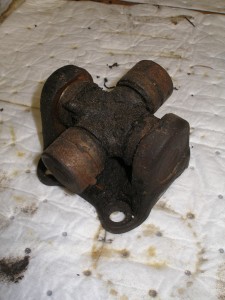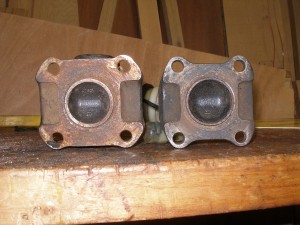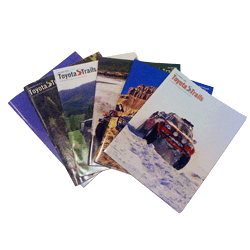By Tony K
One of the great things about our wagons is the fact that most parts can be swapped around between the model years, 1981-90, fairly easily, frequently with only having to unbolt the old part and put on a different one. Driveshaft flanges fall into this category.
 -ID the Third Member-
-ID the Third Member-
As far as the driveshafts are concerned there is only one difference between early and late components, the size of the flange and the bolt pattern on the third member. Early wagons (81-87) used a non round flange on the pinions and the t-case output shafts. This prevents you from directly connecting the newer t-cases and third members (62’s 88-90) which used a round flange that has a more square pattern for the bolts.
If you are a numbers type of person, the early stuff uses a bolt pattern that measures 60mm by 68.5mm while the newer components measure 66mm by 68.5mm, center to center of the bolts. Since there is probably some overlap in the model years, what you need to look for to tell them a apart is the square flange of the older stuff and the large round plate of the late model flange. This difference in the bolt pattern is what prevents you from directly swapping components.
 But it’s easy to swap the ends off of a driveshaft (the short yoke that connects the u-joint to the flange) and install the compatible one you need to match your third member or t-case. This is much easier than pulling the pinion flange or t-case flange. Also beats the heck out of re-drilling the large flange of a newer gear box or differential. What makes this possible is the fact that there was only one size of u-joint used on our wagons, not counting the CV joints used on the front driveshafts in the early wagons, 80 -84.
But it’s easy to swap the ends off of a driveshaft (the short yoke that connects the u-joint to the flange) and install the compatible one you need to match your third member or t-case. This is much easier than pulling the pinion flange or t-case flange. Also beats the heck out of re-drilling the large flange of a newer gear box or differential. What makes this possible is the fact that there was only one size of u-joint used on our wagons, not counting the CV joints used on the front driveshafts in the early wagons, 80 -84.
I prefer doing things this way because pinion and t-case flanges are installed with pre-load and swapping flanges messes with this which I would rather not do. And I much prefer to swap a u-joint flange on a driveshaft over drilling a new set of holes. And like always there is an exception, the 80-84 cv front driveshaft. It you want to connect one of these to a newer t-case you will need to swap the flange on the front of the t-case to accommodate the bolt pattern or better yet drill a second set of holes in the flange itself. This is the one time drilling may be preferable.
-Visual ID-
So how can you tell what model that driveshaft is thats sitting in your yard or for sale somewhere? If you take a look at the pic on the left it’s easy to tell the difference. The flange on the left is from a 1989 FJ62 and the one on the right is from my 82 BJ60. While the holes have a slightly different pattern, they are not hard to tell apart, notice the differences in the webbing between the holes, top and bottom. The older version always drops down more between the holes than the newer version. The newer model is straight between the holes. And don’t forget that even though the patterns are different they both use the exact same u-joint


